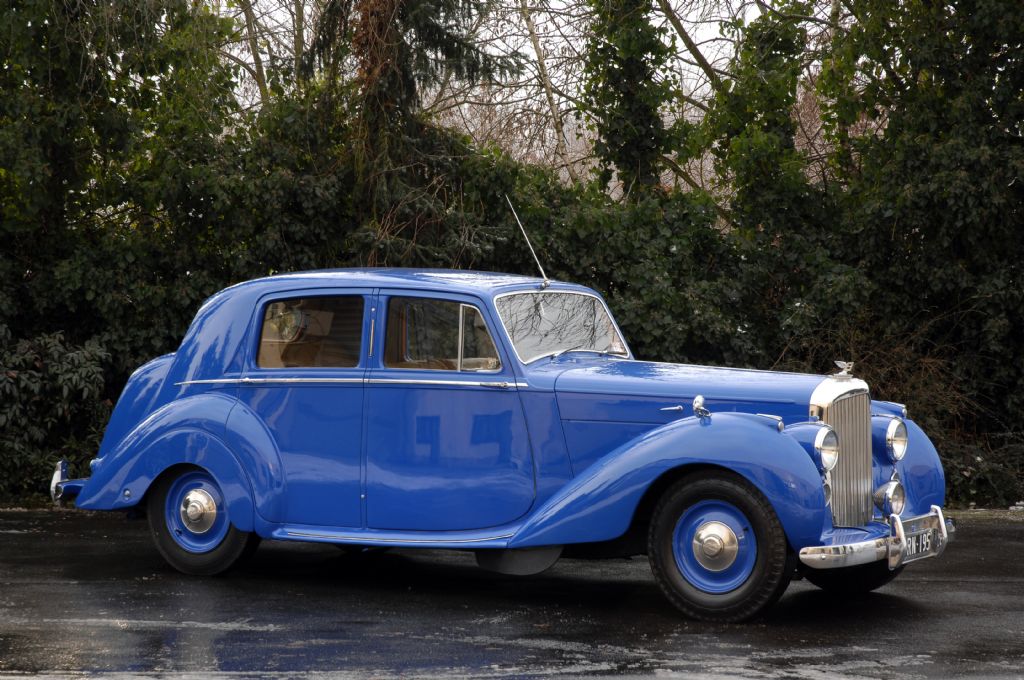Home > Classic Car Data > Bentley MK VI
Bentley MK VI
Intelligence Data:
About the Bentley MK VI
The Bentley Mark VI 4-door standard steel sports saloon was the first post-war luxury car from Bentley.
Announced in May 1946 and produced from 1946 to 1952 it was also both the first car from Rolls-Royce with all-steel coachwork and the first complete car assembled and finished at their factory. These very expensive cars were a genuine success, long-term their weakness lay in the inferior steels forced on them by government's post-war controls.Chassis continued to be supplied to independent coachbuilders.
This Bentley factory finished car was given the name Bentley Mark VI standard steel sports saloon. This shorter wheelbase chassis and engine was a variant of the Rolls-Royce Silver Wraith of 1946 and, with the same standard steel body and a larger boot became the cautiously introduced Silver Dawn of 1949. The same extended-boot modification was made to the Mark VI body in 1952 and the result became known as the R type Bentley.
The Mark VI 4 1⁄4-litre used an F-head straight-6 engine 4.3 L (4,257 cc/259 cu in) in size. The manufacturer refused to disclose a horse power value for the car (other than Tax Horsepower of 29.4 hp according to the old RAC formula) but an Autocar Magazine road test reproduced in 1950 reported that top gear provided "flexibility down to 6 mph (10 km/h)" and the ability to "climb a hill of 1 in 9 maximum gradient, complicated by bends",all of which supported the manufacturer's contention that power, along with low speed torque, were adequate.
In 1951, a 4 1⁄2-litre, 4.6 L (4,566 cc/278 cu in) version of the engine was introduced. The increase in displacement was accomplished by increasing the bore from 3 1/2 inch to 3 5/8 inch. The later version is sometimes casually referred to as the "big bore" engine, the earlier version as the "small bore" version. The 4 1/2 L version of the engine is as well equipped with a Vokes 30 (later: Vokes 62) full flow oil filter (some earlier 4 1/4 L cars have since been modified to a full flow filtration system).
Carburation in RHD (right hand drive) cars were two horizontal constant-vacuum SU carburetors (type H4 up to B81HP, type H6 from B83 HP on). LHD (left hand drive) cars had a single dual downdraught Stromberg carburetor type AAV26M and a different inlet manifold as fitted in the Rolls Royce Silver Dawn and Silver Wraith
A four-speed syncromesh manual transmission was fitted in all Bentley MK VI with the change lever to the right of the driver on RHD cars and on the column on LHD versions.
4 1⁄4-litre cars had chassis numbers from B 1 AJ through B 400 LJ, with the final two letters indicating the series in which it was built. The "big bore" cars serial numbers begin with B 1 MB (although B 2 MD was the first big bore Mark VI built) and ended with B 300 PV (although B 301 PU was the last one built). Each alphabetic series only contained either even or odd numbers, and 13 was always skipped for the odd-numbered sequences.
The 4.3 L (260 cu in) was referred to as the 4 1⁄4 L and can be quickly identified from its single exhaust in RHD cars. The 4.6 L (280 cu in) is known as the 4 1⁄2 L and features a twin exhaust in RHD cars. In LHD cars the (much less restrictive) twin exhaust system was only fitted with the introduction of the R-type.[17] In addition for "standard steel" Mark VI saloons the single hinged ventilation flap centrally mounted on the top of the bonnet, directly ahead of the windscreen was replaced, on later cars, with two hinged ventilation flaps, mounted at or slightly below knee height, one on each side of the bonnet, ahead of the front doors. The oil filler cap is another way to identify engine type; a plastic cap is typical of a "small bore" engine, a metal cap of a "large bore" engine.
The chassis used leaf springs at the rear and independent coil springing at the front. A control on the steering wheel centre adjusts the hardness of the rear springing by hydraulically adjusting the rear dampers. This is done via opening a check valve that provides pressure by diverting transmission oil to the dampers. A pedal-operated central lubrication system type Bijur-Girling allows oil to be applied to moving parts of the suspension from a central reservoir by using a foot pedal. The 12.25 in (311 mm) drum brakes were assisted by the traditional Rolls-Royce mechanical servo at the transmission.
Steel chassis, pressed steel body
Iron block, alloy head, inlet over exhaust with twin SU carbs
Transmission: Four speed manual or optional HydraMatic four speed auto, rear wheel drive.
Suspension : Independent with double wishbones, coil springs. Rear live axle, semil elliptic leaf springs, lever arm dampers
Steering : Cam and roller
Brakes : drums all round, hydraulic at front with mechanical servo.
Vital Statistics
| Years: | 1946 to 1952 |
| Produced: | 5208 vehicles |
| Capacity: | 4257/4566 cc |
| Engine: | Straight 6 |
| Power: | 146 bhp at 4000 rpm |
| Top Speed: | 100 mph |
| 0-60mph: | 15.2 secs |
| MPG: | 17 |
Source: Wikipedia
Search Database
Classified Alerts
We can help you find the classic vehicle you desire.
Advertise Here
You can advertise your business here. Call us on
01892 457670

